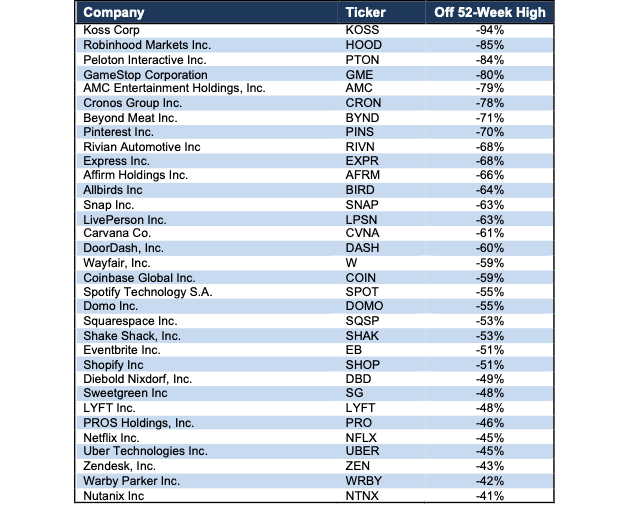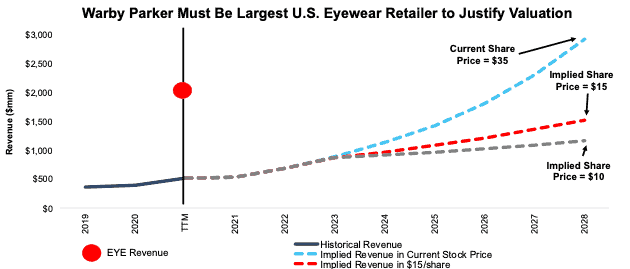We published an update on this Danger Zone pick on June 16, 2023. A copy of the associated report is here.
We counsel investors to take care not to be cut by falling knives – stocks that have seen steep declines but still have further to fall. As the market rotates away from high-flying growth names to more stable cash generators, investors need reliable fundamental research, more than ever, to protect their portfolios from falling knives.
We continue to post an exceptional hit rate on spotting overvalued stocks. Currently, 62 out of our 65 Danger Zone stock picks are down from their 52-week highs by more than the S&P 500. Figure 1 lists the open Danger Zone picks that are down at least 40% from their 52-week highs. Our Focus List Stocks: Short Model Portfolio, the best-of-the-best of our Danger Zone picks, outperformed the S&P 500 as a short portfolio by 36% in 2021 with 29 out of our 31 picks outperforming the index.
This report highlights one particularly dangerous falling knife: Warby Parker (WRBY: $35/share). We highlight four other falling knives in other reports published today: Uber (UBER: $35/share) here, Affirm (AFRM: $60/share) here, Rivian (RIVN: $60/share) here, and DoorDash (DASH: $104/share) here. Each of these stocks have dropped at least 40% from all-time highs, yet still carry at least 40% additional downside risk.
Figure 1: Danger Zone Picks Down >40% From 52-Week High – Performance through 1/28/22
Sources: New Constructs, LLC
Falling Knife: Warby Parker (WRBY): Down 42% from 52-Wk High & 71%+ Downside Remaining
We put Warby Parker (WRBY) in the Danger Zone in September 2021 prior to its IPO. Since the opening price on IPO date, the stock is down 35% while the S&P 500 is up 2%, and shares could fall an additional 71%. We detail Warby Parker’s challenging competitive environment and weaknesses of its business model in our report here.
Valuation Implies Warby Parker Is the Largest U.S. Eyewear Retailer
When we use our reverse discounted cash flow (DCF) model to analyze the future cash flow expectations baked into Warby Parker’s valuation, we provide clear, mathematical evidence that share price is too high and offers very unattractive risk/reward.
To justify its current price of $35/share, Warby Parker must:
- immediately achieve an 8.5% NOPAT margin (equal to National Vision’s TTM NOPAT margin, compared to Warby Parker’s -10%) and
- grow revenue by 29% compounded annually through 2028, which is nearly 5 times the projected global industry growth rate through 2028.
In this scenario, Warby Parker would generate $2.9 billion in revenue in 2028, which is nearly 6x its TTM revenue, and 113% and 146% of Vision Source and Luxottica’s estimated U.S. retail sales in 2020 (most recent available data). Keep in mind, Vision Source and Luxottica were the two largest optical retailers in the United States in 2020.
We think these expectations look increasingly unlikely given Warby Parker’s competitive disadvantage of being an online-first platform with very few physical retail locations. If Warby Parker’s growth slows to anywhere near industry growth rates, the downside in the stock is significant.
57% Downside If Warby Parker Grows at 2x Industry Expectations
We review an additional DCF scenario to highlight the downside risk even if Warby Parker’s revenue growth doubles the expected industry growth rate.
If we assume Warby Parker:
- immediately achieves a NOPAT margin of 8.5%,
- grows revenue by consensus estimates in 2021, 2022, and 2023, and
- grows revenue by 12% each year thereafter (2x industry growth rate) through 2028, then
the stock is worth just $15/share today – a 57% downside. In this scenario, Warby Parker would generate $1.5 billion in revenue in 2028, which is nearly 3x its TTM revenue and equal to estimated eyewear sales from all of Walmart retail locations in 2020.
71% Downside if Warby Parker Grows at Industry Expectations
We review a third DCF scenario to highlight the downside risk should Warby Parker’s revenue growth fall in line with industry expectations.
If we assume Warby Parker:
- immediately achieves a NOPAT margin of 8.5%,
- grows revenue by consensus estimates in 2021, 2022, and 2023, and
- grows revenue by 6% each year thereafter (industry growth rate) through 2028, then
the stock is worth just $10/share today million today – a 71% downside. In this scenario, Warby Parker would generate $1.1 billion in revenue in 2028, which is still more than 2x its TTM revenue.
Figure 2 compares the firm’s implied future revenue in these three scenarios to its historical revenue. For reference, we include the TTM revenue of National Vision (EYE), the third largest U.S. eyewear retailer in 2020.
Figure 2: Historical Revenue vs. Implied Revenue: DCF Scenarios
Sources: New Constructs, LLC and company filings
Each of the above scenarios assume Warby Parker grows revenue, NOPAT, and FCF without increasing working capital or fixed assets. This assumption is highly unlikely but allows us to create best-case scenarios that demonstrate the level of expectations embedded in the current valuation. For reference, Warby Parker’s invested capital increased $60 million (15% of revenue) YoY in 2020. If we assume Warby Parker’s invested capital increases at a similar rate in DCF scenario 2 above, the downside risk is even larger.
Fundamental Research Provides Clarity in Frothy Markets
2022 has quickly shown investors that fundamentals matter and stocks don’t only go up. With a better grasp on fundamentals, investors have a better sense of when to buy and sell – and – know how much risk they take when they own a stock at certain levels. Without reliable fundamental research, investors have no way of gauging whether a stock is expensive or cheap.
As shown above, disciplined, reliable fundamental research shows that even after plummeting, Uber, Affirm, Rivian, DoorDash, and Warby Parker still hold significant downside.
Check out this week’s Danger Zone interview with Chuck Jaffe of Money Life.
This article originally published on January 31, 2022.
Disclosure: David Trainer, Kyle Guske II, and Matt Shuler receive no compensation to write about any specific stock, style, or theme.
Follow us on Twitter, Facebook, LinkedIn, and StockTwits for real-time alerts on all our research.


